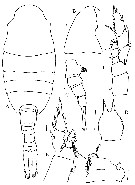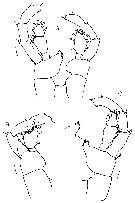|
|
 |
|
Calanoida ( Order ) |
|
|
|
Lucicutiidae ( Family ) |
|
|
|
Lucicutia ( Genus ) |
|
|
| |
Lucicutia hulsemannae Markhaseva & Ferrari, 2005 (F,M) | |
| | | | | | | Ref.: | | | Markhaseva & Ferrari, 2005 (p.1094, figs.F,M) |  issued from : E.L. Markhaseva & F.D. Ferrari in J. Nat. Hist., 2005, 39 (15). [p.1095, Fig.10]. Female (from 13°22'N, 102°07'W): A, habitus (dorsal); B, cephalosome (lateral); C, urosome (lateral, right side); D, rostrum (anterior); E, P1; F, P5. Scale bars: 0.1 mm. Nota : Cephalosome with a pair of low triangular protrusions. Rostral rami divergent from a swollen base. A1 reaching the end of caudal rami. Genital complex symmetrical with irregular, conical plug. 3rd urosome somite longer than adjacent somites : 1.1-1.2 times longer than urosome somite 2 and 1.2-1.4 times longer than anal somite. Anal somite not swollen dorsally. Caudal rami inn dorsal view nearly 3 times longer than anal somite and 5.5 times longer than wide. P1 with large pore on basipod, inner seta of basipod originating on the outer, posterior wall of pore (both states shared among species of the family). P5 3-segmented, medial seta on exopodal segment 2 attenuate and thin toward its tip.
|
 issued from : E.L. Markhaseva & F.D. Ferrari in J. Nat. Hist., 2005, 39 (15). [p.1096, Fig.11]. Male: A, anterior part of cephalosome (dorsal); B, cephalosome (lateral); D, posterior corners of prosome and urosome (lateral, right side); E, rostrum; F, A1 (segments 16-17); G, A1 (18th segment); H, A1 (segments 19-21). Scale bars: 0.1 mm. Nota : Cephalosome laterally with pointed protrusions. Rostrum with rami nearly parallel. A121-segmented (18th the longest). Caudal rami 5.8 times longer than wide.
|
 issued from : E.L. Markhaseva & F.D. Ferrari in J. Nat. Hist., 2005, 39 (15). [p.1097, Fig.12]. Male: A, P5; B, left P5; C, right P5. Different specimens. Scale bars: 0.1 mm. Nota: Right P5 with exopodal segment 1 shorter than 2 and witth a thin sclerotized lamella at mid-length, exopodal segment 2 with broad medial hirsute lobe, basipod variable in shape, usually with knob along medial margin ; 3 rd exopodal segment of left P5 elongae, oval-rectangular, basipod with a medial projection pointed distally, with varying number of teeth at tip.
| | | | | Compl. Ref.: | | | Williams R., 2013 (p.71, figs., Table 3.2, 3.4, 3.6, 3.7, Appendix A, C; C & N composition, trophic level) | | | | NZ: | 1 | | |
|
Distribution map of Lucicutia hulsemannae by geographical zones
|
| | | | Loc: | | | NE Pacif. (SW Mexico: Volcano 7), Tehuantepec Bowl - Costa Rica Dome
Type locality: 13°22'N, 102°07'W. | | | | N: | 2 | | | | Lg.: | | | (929) F: 6,25-6,3; M: 5,8-6; {F: 6,25-6,30; M: 5,80-6,00} | | | | Rem.: | Bathypelagic (693-985 m).
The following characters distinguish females of L. hulsemannae from L. grandis, L. bradyana and L. wolfendeni : Urosome somite 2 significantly wider than 3, and urosome somite 3 longer than than urosome somite 2 and anal somite (in L. grandis, L. bradyana, L. wolfendeni with urosome somite 2 not significantly wider than urosome somite 3, and urosomite 3 not longer than 2 or the anal somite). The anal somite is not swollen dorsally or ventrally (in L. grandis, L. bradyana it is large and swollen dorsally and ventrally, respectively). The rostral rami diverge from the base ( (in L. grandis do not diverge). The medial seta on the 2 nd exopod of P5 is thin toward its tip while the tip of L. bradyana is robust. The plug of the genital double-somite is irregularly conical, but round in L. bradyana or oval in L. wolfendeni. Males differ from those of L. grandis, L. bradyana, L. wolfendeni in having a low chitinous lamella at about mid-length of the 1st exopodal segment of the right P5. (there is no lamella on the other three species). ; the 2nd exopodal segment has a hirsute medial lobe (this lobe absent in the other three species). | | | Last update : 16/01/2015 | |
|
|
 Any use of this site for a publication will be mentioned with the following reference : Any use of this site for a publication will be mentioned with the following reference :
Razouls C., Desreumaux N., Kouwenberg J. and de Bovée F., 2005-2025. - Biodiversity of Marine Planktonic Copepods (morphology, geographical distribution and biological data). Sorbonne University, CNRS. Available at http://copepodes.obs-banyuls.fr/en [Accessed October 17, 2025] © copyright 2005-2025 Sorbonne University, CNRS
|
|
 |
 |






